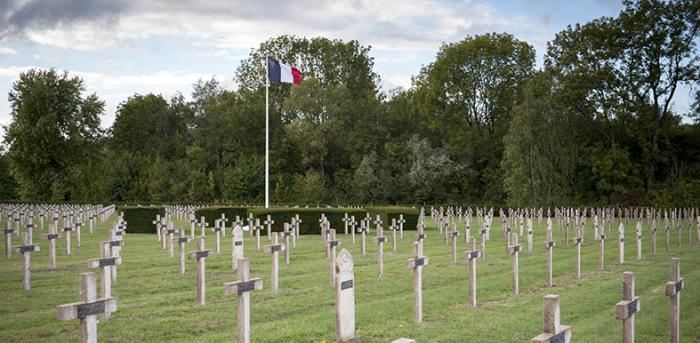
Nécropole nationale de Choloy-Ménillot. © ECPAD
Pour accéder au panneau d'information de la nécropole, cliquer ici 
La nécropole nationale de Choloy-Ménillot regroupe les dépouilles de soldats morts pour la France entre 1914 et 1918. Créée en 1914, pour inhumer tous ceux qui succombaient à leurs blessures lors de leur hospitalisation dans les différentes unités médicales de la région de Toul, cette nécropole est aménagée jusqu'en 1938 pour y réunir les corps d’autres soldats exhumés d'autres cimetières, notamment celui de Ménil-la-Tour. Près de 2 000 soldats français y sont rassemblés. À leurs côtés, reposent neuf soldats français décédés en 1939-1945. Par ailleurs, en ce lieu a été aménagé un carré militaire destiné à regrouper les corps de soldats alliés inhumés initialement dans des cimetières provisoires du Sud de la Meurthe-et-Moselle et de la région de Neufchâteau. Au total, 86 Russes, 49 Polonais, six Roumains, deux Serbes et un Britannique y reposent. À l’intérieur de la nécropole, une colonne en pierre a été élevée à l’initiative de l’association des Loups du Bois-le-Prêtre en mémoire de leurs camarades morts pour la France.
Octobre 1914-mai 1915. Les combats du Bois le Prêtre
Fin septembre 1914, après les échecs sur le Grand couronné de Nancy puis sur la Marne, l’armée allemande lance une nouvelle offensive sur les Hauts de Meuse. Le 23 septembre, l'ennemi atteint Saint-Mihiel, créant ainsi une poche dans les positions françaises. Aussi, pour dégager cet étau, les combats se multiplient en forêt d’Apremont, au bois d’Ailly ou au Bois-brûlé. De nouvelles actions sont conduites sur les flancs du saillant, les unes, au nord, situées aux Eparges et les autres, au sud, au Bois-le-Prêtre.
Dominant la ville de Pont-à-Mousson et la vallée de la Meuse, le Bois-le-Prêtre représente un observatoire idéal et devient, à ce titre, le théâtre d’une bataille ininterrompue. Cet effort est porté principalement par les hommes de la 73e division d’infanterie de réserve. En raison des conditions climatiques difficiles et de la résistance de l'ennemi, la progression des Français est difficile. Pendant des mois, certaines positions tels que le ravin du Père Hilarion ou encore la Croix des Carmes sont durement disputées. Attaques et contre-attaques se succèdent. Le 12 mai, les Français conquièrent la crête du Bois-le-Prêtre, mais l'ennemi s'accroche encore aux pentes. Au cours de ces opérations, près de 7 000 hommes disparaissent pour chacun des belligérants. Français et Allemands s’enterrent dans des tranchées pilonnées par l’artillerie ou des explosions souterraines. Mais le front se fige et Saint-Mihiel reste aux mains des Allemands jusqu'en septembre 1918.
Les hôpitaux militaires de Toul et de ses environs
Dès les premiers combats, les blessés sont nombreux en Lorraine. Intégrée au système défensif de la région fortifiée de Verdun, la garnison de Toul est dotée d'hôpitaux militaires et d'hôpitaux mixtes où civils et soldats sont soignés. Mais, très vite, ces établissements sont saturés. Le service de santé doit s’adapter rapidement pour sauver le plus grand nombre de soldats et de civils. Il ouvre alors de nouvelles structures médicales. Les casernes, les collèges mais aussi les édifices religieux sont ainsi réquisitionnés pour devenir des hôpitaux complémentaires.
Le traitement des blessés est fonction de leur état. Il débute sur le front dès l’arrivée au poste de secours avancé. Aussitôt, en quelques minutes, les blessés sont traités suivant leurs chances de guérison. Ceux qui peuvent être déplacés sont dirigés vers des ambulances, petites unités médico-chirurgicales. À Toul, les ambulances 2/8, 5/38, 5/68 font office d’antenne de ramassage, de filtrage et de catégorisation avant un transfert dans l’un des hôpitaux de la ville. Des ambulances automobiles chirurgicales - dites « autochirs » - complètent ce dispositif. Ces hôpitaux mobiles permettent de prendre en charge les grands traumatisés. Grâce aux progrès de la radiographie, les victimes d’éclats d’obus peuvent ainsi être opérées plus rapidement. Toutefois, malgré les progrès de la médecine, de nombreux soldats succombent à leurs blessures et sont inhumés dans des cimetières militaires tels que celui de Choloy-Ménillot.
En 1918, l’armée américaine installe un très important complexe hospitalier dans le secteur de Toul. Il se compose de douze hôpitaux spécialisés qui reçoivent les nombreux blessés, notamment ceux de la bataille de Saint-Mihiel en septembre 1918.
Élément remarquable
Monument aux morts des 73e et 128e DI des Loups du Bois-le-Prêtre, 1914-1918.